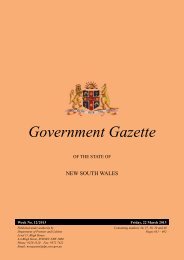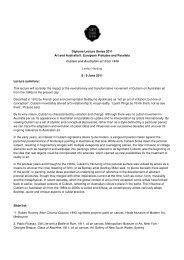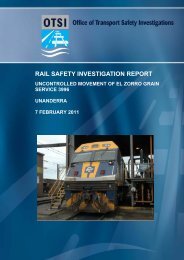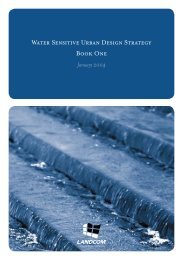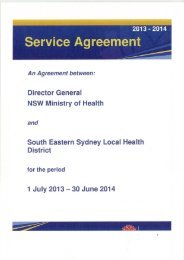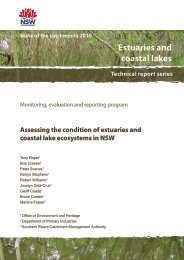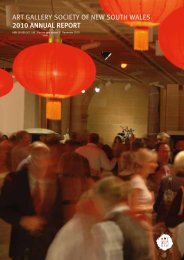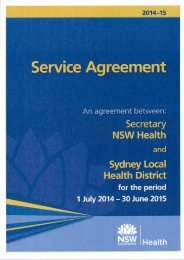Nundah - Office of Transport Safety Investigations - NSW Government
Nundah - Office of Transport Safety Investigations - NSW Government
Nundah - Office of Transport Safety Investigations - NSW Government
You also want an ePaper? Increase the reach of your titles
YUMPU automatically turns print PDFs into web optimized ePapers that Google loves.
Draft—Do Not CopyRAIL SAFETY INVESTIGATION REPORTFATAL LEVEL CROSSING COLLISIONNUNDAH4 MAY 2012
RAIL SAFETY INVESTIGATION REPORTFATAL LEVEL CROSSING COLLISIONNUNDAH4 MAY 2012Released under the provisions <strong>of</strong>Section 45C (2) <strong>of</strong> the <strong>Transport</strong> Administration Act 1988 andSection 67 (2) <strong>of</strong> the Rail <strong>Safety</strong> Act 2008Investigation Reference 04563
Published by:The <strong>Office</strong> <strong>of</strong> <strong>Transport</strong> <strong>Safety</strong> <strong>Investigations</strong>Postal address: PO Box A2616, Sydney South, <strong>NSW</strong> 1235<strong>Office</strong> location: Level 17, 201 Elizabeth Street, Sydney <strong>NSW</strong> 2000Telephone: 02 9322 9200Accident and incident notification: 1800 677 766Facsimile: 02 9322 9299E-mail:Internet:info@otsi.nsw.gov.auwww.otsi.nsw.gov.auThis Report is Copyright. In the interests <strong>of</strong> enhancing the value <strong>of</strong> the informationcontained in this Report, its contents may be copied, downloaded, displayed,printed, reproduced and distributed, but only in unaltered form (and retaining thisnotice). However, copyright in material contained in this Report which has beenobtained by the <strong>Office</strong> <strong>of</strong> <strong>Transport</strong> <strong>Safety</strong> <strong>Investigations</strong> from other agencies,private individuals or organisations, belongs to those agencies, individuals ororganisations. Where use <strong>of</strong> their material is sought, a direct approach will needto be made to the owning agencies, individuals or organisations.Subject to the provisions <strong>of</strong> the Copyright Act 1968, no other use may be made <strong>of</strong>the material in this Report unless permission <strong>of</strong> the <strong>Office</strong> <strong>of</strong> <strong>Transport</strong> <strong>Safety</strong><strong>Investigations</strong> has been obtained.
THE OFFICE OF TRANSPORT SAFETY INVESTIGATIONSThe <strong>Office</strong> <strong>of</strong> <strong>Transport</strong> <strong>Safety</strong> <strong>Investigations</strong> (OTSI) is an independent <strong>NSW</strong> agency whosepurpose is to improve transport safety through the investigation <strong>of</strong> accidents and incidents inthe rail, bus and ferry industries. OTSI investigations are independent <strong>of</strong> regulatory,operator or other external entities.Established on 1 January 2004 by the <strong>Transport</strong> Administration Act 1988, and confirmed byamending legislation as an independent statutory <strong>of</strong>fice on 1 July 2005, OTSI is responsiblefor determining the causes and contributing factors <strong>of</strong> accidents and to makerecommendations for the implementation <strong>of</strong> remedial safety action to prevent recurrence.Importantly, however, OTSI does not confine itself to the consideration <strong>of</strong> just those mattersthat caused or contributed to a particular accident; it also seeks to identify any transportsafety matters which, if left unaddressed, might contribute to other accidents.OTSI’s investigations are conducted under powers conferred by the Passenger <strong>Transport</strong>Act 1990. OTSI investigators normally seek to obtain information cooperatively whenconducting an accident investigation. However, where it is necessary to do so, OTSIinvestigators may exercise statutory powers to interview persons, enter premises andexamine and retain physical and documentary evidence.It is not within OTSI’s jurisdiction, nor an object <strong>of</strong> its investigations, to apportion blame ordetermine liability. At all times, OTSI’s investigation reports strive to reflect a “Just Culture”approach to the investigative process by balancing the presentation <strong>of</strong> potentiallyjudgemental material in a manner that properly explains what happened, and why, in a fairand unbiased manner.Once OTSI has completed an investigation, its report is provided to the <strong>NSW</strong> Minister for<strong>Transport</strong> for tabling in Parliament. The Minister is required to table the report in bothHouses <strong>of</strong> the <strong>NSW</strong> Parliament within seven days <strong>of</strong> receiving it. Following tabling, thereport is published on OTSI’s website at www.otsi.nsw.gov.au.OTSI cannot compel any party to implement its recommendations and its investigativeresponsibilities do not extend to overseeing the implementation <strong>of</strong> recommendations itmakes in its investigation reports. However, OTSI takes a close interest in the extent towhich its recommendations have been accepted and acted upon. In addition, a mechanismexists through which OTSI is provided with formal advice by the Independent <strong>Transport</strong><strong>Safety</strong> Regulator (ITSR) in relation to the status <strong>of</strong> actions taken by those parties to whom itsrecommendations are directed.
OTSI Rail <strong>Safety</strong> InvestigationCONTENTSTABLE OF PHOTOGRAPHSiiTABLE OF FIGURESiiEXECUTIVE SUMMARYiiiPART 1 FACTUAL INFORMATION 1Overview 1Location 1The track 1The train 2The train crew 3The utility 3The utility driver 3Environmental conditions 4The crossing 5The collision 11Emergency response 13PART 2 ANALYSIS 14Speed 14Visibility 14Signage 15Distraction 17Local knowledge 17Train frequency 17PART 3 OTHER ISSUES 19Crossing standards 19Interface agreement 20Location <strong>of</strong> UHVA compound 22Previous incidents 24PART 4 FINDINGS 25Immediate cause 25Contributing factors 25Other safety factors 25PART 5 RECOMMENDATIONS 26Singleton Council 26Upper Hunter Valley Alliance 26Singleton Council and Australian Rail Track Corporation together 26PART 6 APPENDICES 27Appendix 1: Sources and submissions 27Fatal Level Crossing Collision, <strong>Nundah</strong>, 4 May 2012i
OTSI Rail <strong>Safety</strong> InvestigationTABLE OF PHOTOGRAPHSPhotograph 1: Road work sign, pavement marking and early warning sign 6Photograph 2: View on approach to bridge 7Photograph 3: Looking towards the crossing from the bridge 7Photograph 4: Railway crossing and stop signs 8Photograph 5: Crossing in sight, track obscured 9Photograph 6: Road surface on approach to crossing 9Photograph 7: Visual obstruction due to compound 9Photograph 8: View to the left when stopped at stop sign 10Photograph 9: Clear view taken 3 metres from nearest rail 11Photograph 10: View to the right when stopped at stop sign 11Photograph 11: Extent <strong>of</strong> damage to the utility 12Photograph 12: View to the left when stopped at stop sign 20TABLE OF FIGURESFigure 1: Incident location 2Figure 2: Sun direction relative to utility and train 4Figure 3: Location <strong>of</strong> road signs on approach from the north 16Fatal Level Crossing Collision, <strong>Nundah</strong>, 4 May 2012ii
OTSI Rail <strong>Safety</strong> InvestigationEXECUTIVE SUMMARYAt 0911 1 on Friday 4 May 2012, an unladen coal train travelling north-west on theMain North line collided with a utility on a railway crossing on Middle Falbrook Road,Glennies Creek, at a rail location known as <strong>Nundah</strong>. The driver <strong>of</strong> the utility wasfatally injured in the collision.The train, operated by QR National Limited, was less than 100 metres from thecrossing and travelling at 71 km/h when the crew saw the utility approaching thecrossing from their right at a moderate speed and then continuing onto the crossingwithout appearing to slow. The train struck the left side door <strong>of</strong> the utility, draggingthe vehicle for 70 metres and finally stopping under emergency braking about 400metres past the point <strong>of</strong> impact, with the utility on the right hand side <strong>of</strong> the train onthe adjacent track. A laden Pacific National coal train travelling in the oppositedirection had been standing for some minutes with its headlight extinguishedapproximately 800 metres from the crossing on the adjacent track, and its crewimmediately secured their train and hurried up the track to lend assistance.The railway crossing was passively protected by stop signs and associated roadsidesigns and road markings, except for a stop line on the road immediately before thecrossing. The driver’s vision <strong>of</strong> trains approaching from the south-east was limited bythe presence <strong>of</strong> a work compound to his left. However, the stop sign before thecrossing was visible for a distance <strong>of</strong> at least 85 metres.The reason the utility was driven onto the crossing without stopping is unknown.However, it is possible that the driver was distracted by the busy visual environmentas he approached the crossing and that the driver’s view <strong>of</strong> the train approachingfrom his left was compromised by the presence <strong>of</strong> the work compound and fences inhis line <strong>of</strong> sight.Recommendations made relate to the need for rigour in assessing risk caused by theeffect <strong>of</strong> construction sites on visibility at level crossings; marking <strong>of</strong> appropriatelyplaced stop lines on the approaches to the railway crossing, and finalisation <strong>of</strong>interface agreements between Singleton Council and the Australian Rail TrackCorporation.1Times in this report are in 24-hour clock form, and are in Eastern Standard Time, 10 hours ahead <strong>of</strong> CoordinatedUniversal Time.Fatal Level Crossing Collision, <strong>Nundah</strong>, 4 May 2012iii
OTSI Rail <strong>Safety</strong> InvestigationPART 1 FACTUAL INFORMATIONOverview1.1 At 0911 on Friday 4 May 2012, locomotive 5033, the lead locomotive <strong>of</strong> anempty coal train, collided with a Ford Falcon utility on a level crossing onMiddle Falbrook Road, Glennies Creek, at a rail location known as <strong>Nundah</strong>.The train, designated BW935 and operated by QR National Limited, wastravelling in a north-westerly direction away from Singleton, while the utilitywas travelling south-west along Middle Falbrook Road.1.2 The locomotive struck the front half <strong>of</strong> the utility’s left side, reducing its widthby about 50% at the level <strong>of</strong> the passenger door. The utility was dragged forapproximately 70 metres, rotating clockwise through about 90 degrees beforecoming to rest to the right <strong>of</strong> the train on the adjacent line. The driver <strong>of</strong> theutility was fatally injured in the collision.1.3 At the time <strong>of</strong> the collision, a loaded Pacific National coal train designatedNB914 was standing approximately 800 metres west <strong>of</strong> the crossing on theadjacent line.Location1.4 <strong>Nundah</strong> is a rail location in the Camberwell to Mt. Owen Section <strong>of</strong> the MainNorth line, 251 km by rail from Sydney and a short distance north-west <strong>of</strong> therailway crossing at which the collision occurred (see Figure 1). Thesurrounding area is known as Glennies Creek.The track1.5 The incident occurred on a double track section <strong>of</strong> the Main North line in railterritory leased by the Australian Rail Track Corporation (ARTC) from the<strong>NSW</strong> <strong>Government</strong>. Under the terms <strong>of</strong> the lease, ARTC is responsible fortrack maintenance and train control functions.1.6 The approach to the Middle Falbrook Road rail crossing from the south slopesdownhill with a gradient <strong>of</strong> 1:105, decreasing to 1:213 approximately 125metres before the crossing.Fatal Level Crossing Collision, <strong>Nundah</strong>, 4 May 2012 1
OTSI Rail <strong>Safety</strong> InvestigationMt Owen JunctionGlennies CreekMiddle Falbrook Road<strong>Nundah</strong>Incident locationCamberwellNew England HighwayCamberwell JunctionCopyright© Map Created by Geoscience AustraliaSingletonFigure 1: Incident location1.7 Permitted track speeds varied according to the train type, with a maximumpermitted speed <strong>of</strong> 110 km/h for trains travelling from the south. Coal trainswith a maximum axle loading <strong>of</strong> 25 tonnes were restricted to 80 km/h, whilethose with a maximum axle loading <strong>of</strong> 30 tonnes were restricted to 60 km/h.For trains travelling from the north, the maximum permitted track speed was100 km/h, with coal trains again restricted to 80 or 60 km/h depending onwagon axle load limits.The train1.8 The train involved in the incident was an empty coal train owned, operatedand crewed by QR National Limited (QR). It consisted <strong>of</strong> 74 QHBH wagonsdrawn by one 5020 Class locomotive and one 5000 Class locomotive, andwas designated BW935.Fatal Level Crossing Collision, <strong>Nundah</strong>, 4 May 2012 2
OTSI Rail <strong>Safety</strong> Investigation1.9 The train was 1280 metres long with a mass <strong>of</strong> 1998 tonnes. It had leftKooragang on time at 0730 and was on schedule as it approached thecrossing.The train crew1.10 The driver <strong>of</strong> the train was 46 years <strong>of</strong> age and had been employed by QR forfive years. After three years <strong>of</strong> training, he became a train driver, a position hehad held for the past two years.1.11 The second person was 32 years <strong>of</strong> age and his tasks included observing andcalling signals, maintaining documentation and communication with NetworkControl and the loading terminals.1.12 Both crew members were tested after the collision for the presence <strong>of</strong> drugsand alcohol, with negative results.The utility1.13 The utility was a white Ford Falcon AU manufactured in the year 2000. It hadrecently passed its annual roadworthiness inspection. Prior to this, a fluid leakfrom the braking system had been rectified and a general brake overhaulcarried out, but no other significant repairs had recently been performed.The utility driver1.14 The driver <strong>of</strong> the utility was a 50 year old male who was from interstate buthad been living locally since moving into his current role. He was employedas a Project Manager and had been in that position for seven months.1.15 His health was generally good, although he was slightly overweight and haddiabetes which was controlled effectively by diet. He was not on anymedication at the time <strong>of</strong> the collision and there was no evidence in the postcrashmedical examination <strong>of</strong> any substance that may have affected hisdriving performance.1.16 On the day <strong>of</strong> the collision he had left his place <strong>of</strong> residence in nearbySingleton to travel to a business appointment, his route taking him alongMiddle Falbrook Road and over the railway crossing. This route, which hadFatal Level Crossing Collision, <strong>Nundah</strong>, 4 May 2012 3
OTSI Rail <strong>Safety</strong> Investigationbeen a through road to the Pacific Highway prior to the development <strong>of</strong> theIntegra coal mines, provided access to Integra’s underground mining facilityand to other private properties.1.17 Indications from both the driver’s manager and his family were that he washappy in his work and was good at his job.Environmental conditions1.18 The weather at Singleton was not recorded by the Bureau <strong>of</strong> Meteorology onthe day <strong>of</strong> the collision, but records from the days before and after, and fromnearby recording points on the day, indicate that the temperature at 0900 wasaround 15°C and there was a light breeze. The sun was at an azimuth <strong>of</strong> 44.5°and an altitude <strong>of</strong> 28.2°. The alignment <strong>of</strong> the road at the crossing wasapproximately 26° east <strong>of</strong> north, resulting in a sunlight direction from behindand to the left side <strong>of</strong> the utility driver and from the right hand side <strong>of</strong> the traindriver, as illustrated in Figure 2.1.19 Neither driver would have been looking toward the sun as they approachedthe crossing.NSunlightDirection <strong>of</strong> utilityWEDirection <strong>of</strong> trainSFigure 2: Sun direction relative to utility and trainFatal Level Crossing Collision, <strong>Nundah</strong>, 4 May 2012 4
OTSI Rail <strong>Safety</strong> InvestigationThe crossing1.20 The Middle Falbrook Road railway crossing is on the Main North line 251.494km from a reference point at Sydney’s Central Station.1.21 The crossing was protected by a passive control system comprising stopsigns, associated warning signs and road markings, alerting drivers <strong>of</strong> roadvehicles to the presence <strong>of</strong> the crossing but requiring drivers to detect thepresence <strong>of</strong> trains by direct observation.1.22 As Middle Falbrook Road is a public road, responsibility for the level crossingsignage and road markings resides with the roads authority, in this caseSingleton Council.1.23 Middle Falbrook Road runs in a generally north-south direction and wascovered by a speed limit <strong>of</strong> 80 km/h. However, due to road works on theapproach to the crossing from the north at the time <strong>of</strong> the collision, a “RoadWork” sign had been erected approximately 200 metres before the crossingand a local speed limit <strong>of</strong> 25 km/h imposed.1.24 The road sloped slightly downward as it approached the crossing from thenorth before rising slightly immediately before the crossing and levelling as itcrossed the railway line at right angles.1.25 The approach by rail from the south-east was around a left hand curve <strong>of</strong> 600metres radius leading into a straight <strong>of</strong> approximately 250 metres lengthimmediately before the crossing. The crossing was visible to approachingtrains for a distance <strong>of</strong> approximately 440 metres.1.26 On the approach by road from the north (i.e., the path <strong>of</strong> the utility) the firstindication <strong>of</strong> the crossing was the pavement marking shown in Photograph 1,located approximately 220 metres from the crossing. Although visible at thetime <strong>of</strong> the collision, the marking was well-worn and inconspicuous on a poorroad surface. More conspicuous at this point was a “Railway Ahead” warningin the form <strong>of</strong> a black steam locomotive silhouetted on a yellow backgroundwith which the previously mentioned Road Work sign had been co-located.This sign is described in Australian Standard 1742.7—2007 2 as an advance2Australian Standard AS 1742.7—2007, Manual <strong>of</strong> uniform traffic control devices, Part 7: Railway crossings.Fatal Level Crossing Collision, <strong>Nundah</strong>, 4 May 2012 5
OTSI Rail <strong>Safety</strong> Investigationwarning <strong>of</strong> a crossing with passive control and its distance from the crossing isconsistent with this purpose.Photograph 1: Road work sign, pavement marking and early warning sign1.27 A “Bridge Load Limit” sign and a “Caution Trucks Turning” sign were colocated50 metres further on, followed after a further 12 metres by a “StopSign Ahead” warning, as seen in Photograph 2. As these signs came intoview, a bridge with safety barriers placed alongside its railings could also beseen.Fatal Level Crossing Collision, <strong>Nundah</strong>, 4 May 2012 6
OTSI Rail <strong>Safety</strong> InvestigationPhotograph 2: View on approach to bridge1.28 Once across the bridge and approximately 100 metres from the crossing, theroad could be seen curving to the right. The crossing was not yet visible,concealed by the foliage <strong>of</strong> trees growing beside the bridge, as seen inPhotograph 3. However, an additional warning sign, as specified in theAustralian Standard for use with a give way sign, was visible on the left <strong>of</strong> theroadway although partly obscured by foliage. An Upper Hunter Valley Alliance(UHVA) 3 sign had been co-located with it.Crossing warning signUHVA signPhotograph 3: Looking towards the crossing from the bridge3The Upper Hunter Valley Alliance was an alliance <strong>of</strong> ARTC, Leighton Contractors, Parsons Brinckerh<strong>of</strong>f, C<strong>of</strong>feyGeotechnics, KMH Environmental and ARTC Ansaldo STS Network Control Systems Alliance (AANCSA).Fatal Level Crossing Collision, <strong>Nundah</strong>, 4 May 2012 7
OTSI Rail <strong>Safety</strong> Investigation1.29 On the left <strong>of</strong> the road immediately before the crossing, a UHVA compoundcontaining a parking area and site <strong>of</strong>fice had been constructed. When viewedfrom the bridge, the entrance to the compound was directly ahead with theroad curving to the right. From 20 metres further on, a stop sign and a railwaycrossing sign could be seen but the track and crossing were obscured byfencing around the UHVA compound and undergrowth to the right <strong>of</strong> theroadway (Photograph 4).Stop signCompoundentranceRailwaycrossingsignPhotograph 4: Railway crossing and stop signs1.30 After a further 30 metres, the crossing could be seen (Photograph 5) and wasclearly visible from that point onwards. However, the railway track to the leftremained hidden by the UHVA compound and car park and by long grass. Atthe time <strong>of</strong> the collision, the vehicles in the car park included a mid-sized busand a pantechnicon parked nose-in against the south western fence whichwould have further obstructed the utility driver’s view <strong>of</strong> any train approachingfrom the left as he drove towards the crossing.1.31 The road pavement on the approach to the crossing was in a poor state <strong>of</strong>repair, as can be seen in Photograph 6. The surface was <strong>of</strong> broken andpotholed asphalt interspersed with dirt and there was no stop line visible.1.32 The car park and compound fencing continued to present an obstruction to thedriver’s view to the left approaching the crossing, as seen in Photograph 7.Fatal Level Crossing Collision, <strong>Nundah</strong>, 4 May 2012 8
OTSI Rail <strong>Safety</strong> InvestigationPhotograph 5: Crossing in sight, track obscuredPhotograph 6: Road surface on approach to crossingPhotograph 7: Visual obstruction due to compoundFatal Level Crossing Collision, <strong>Nundah</strong>, 4 May 2012 9
OTSI Rail <strong>Safety</strong> Investigation1.33 Had the driver stopped at the stop sign, which was 7.5 metres from thenearest rail, his view would have been as seen in Photograph 8. Note the rear<strong>of</strong> a train on the bend, obscured by the fence posts. At the time the utilitypassed the stop sign without stopping, the train would have beenapproximately 50 metres, or 2.5 seconds, from the point <strong>of</strong> impact.Photograph 8: View to the left when stopped at stop sign1.34 A clear view <strong>of</strong> the track to the left was not available to the driver until thevehicle had passed the stop sign and was no more than 3.5 metres from thenearest rail (Photograph 9).1.35 In contrast, the view to the right (Photograph 10), although partially obstructedby a signal hut, was otherwise clear and a train standing approximately 800metres away which was present at the time <strong>of</strong> the incident, was clearly visible.Note that the glare from the afternoon sun seen in this photograph would nothave been a factor at the time <strong>of</strong> the collision.Fatal Level Crossing Collision, <strong>Nundah</strong>, 4 May 2012 10
OTSI Rail <strong>Safety</strong> InvestigationPhotograph 9: Clear view taken 3 metres from nearest railSignal hutTrainPhotograph 10: View to the right when stopped at stop signThe collisionUnladen QR National coal train BW935 left Kooragang coal terminal at 0730on Friday 4 May, passing through Singleton as scheduled at 0905. Whenabout 200 metres from Middle Falbrook Road level crossing, the driverFatal Level Crossing Collision, <strong>Nundah</strong>, 4 May 2012 11
OTSI Rail <strong>Safety</strong> <strong>Investigations</strong>ounded the horn as is routinely required. When less than 100 metres (5seconds) from the crossing and travelling at an indicated speed <strong>of</strong> 71 km/h,the driver saw a white utility approaching from the right. The driver observedthat “It didn’t look like the vehicle was going fast …” and didn’t appear to slowas it neared the crossing. The driver sounded the horn twice more.1.36 The other crew member on the train also saw the utility approaching thecrossing from his right. His impression was that the utility was travelling slowlyas it approached the crossing and continued at the same speed withoutslowing further.1.37 At 0910:48 the right front corner <strong>of</strong> the lead locomotive struck the left side <strong>of</strong>the utility in line with the seat. The utility was dragged for 70 metres, rotatingclockwise through approximately 90° before coming to rest on the adjacenttrack to the right <strong>of</strong> the train. The train travelled a further distance <strong>of</strong>approximately 330 metres, the driver having activated emergency braking atabout the time <strong>of</strong> the impact.Photograph 11: Extent <strong>of</strong> damage to the utilityFatal Level Crossing Collision, <strong>Nundah</strong>, 4 May 2012 12
OTSI Rail <strong>Safety</strong> Investigation1.38 Damage to the utility was extreme, with its width reduced by approximately50% at the seating position (Photograph 11).1.39 As the QR train was approaching the crossing, Pacific National coal trainNB914 was standing on the adjacent track approximately 800 metres northwest<strong>of</strong> the crossing and the crew, on seeing the collision, secured their trainand hurried up the track to render assistance.Emergency response1.40 Emergency services were advised <strong>of</strong> the collision at 0912, and an ambulancearrived at approximately 0935. The driver <strong>of</strong> the utility was found to have beenfatally injured in the collision.1.41 An ARTC site co-ordinator arrived at approximately 1000, and ARTC’s safetyinvestigator arrived at approximately 1200.1.42 The OTSI Duty <strong>Office</strong>r received notification <strong>of</strong> the collision at 0932 and twoOTSI investigators travelled to the site, arriving at 1345 to conduct apreliminary investigation.Fatal Level Crossing Collision, <strong>Nundah</strong>, 4 May 2012 13
OTSI Rail <strong>Safety</strong> InvestigationPART 2 ANALYSISSpeed2.1 The train crew estimated the train’s speed approaching the crossing to beabout 70 km/h, with the permitted track speed being 80 km/h. The locomotiveswere equipped with electronic data loggers and analysis <strong>of</strong> the stored dataleading up to and immediately after the collision confirmed that the train hadbeen travelling at 71 km/h before slowing slightly and then coming to a stopunder emergency braking.2.2 The approach speed <strong>of</strong> the utility towards the crossing was described by thetrain drivers as moderate, with no apparent slowing as it neared the crossing.No independent witness has been found to corroborate this impression andthe utility was not visible in the video record obtained from a forward facingcamera on the lead locomotive until less than one second before the collision.2.3 Analysis <strong>of</strong> individual frames <strong>of</strong> the video record <strong>of</strong> the last second before thecollision, where either the front <strong>of</strong> the utility or its shadow was visible, indicatethat the likely speed <strong>of</strong> the utility was in the range <strong>of</strong> 30 to 40 km/h.2.4 Section 121 <strong>of</strong> the <strong>NSW</strong> Road Rules requires the following:A driver at a level crossing with a stop sign must:(a) stop as near as practicable to, but before reaching, the stop lineor, if there is no stop line, as near as practicable to, but beforereaching, the stop sign, and(b) give way to any train or tram on, approaching or entering thecrossing.2.5 A vehicle travelling at 40 km/h would take approximately 35 metres to stop,assuming a reaction time <strong>of</strong> 2 seconds and an easily achievable decelerationrate <strong>of</strong> 5 m/s 2 . The stop sign was visible for a distance <strong>of</strong> at least 85 metres.Visibility2.6 It was a clear dry morning at the time <strong>of</strong> the collision, with the sun at analtitude <strong>of</strong> 28.2° and behind the left shoulder <strong>of</strong> the utility driver as heFatal Level Crossing Collision, <strong>Nundah</strong>, 4 May 2012 14
OTSI Rail <strong>Safety</strong> Investigationapproached the railway crossing. The prevailing daylight would have providednear optimal visibility conditions for the utility driver.2.7 The video record from the locomotive indicates that visibility for the locomotivecrew as they approached the crossing was not adversely affected by the sunposition or the level <strong>of</strong> daylight.2.8 However, there were obstructions to the line <strong>of</strong> sight from both train and utilityas they approached. From the perspective <strong>of</strong> the train driver, the utility’sapproach was obscured by trees and undergrowth, by the buildings in theUHVA compound, by the compound fencing and by vehicles in the compoundcar park. Visual obstruction such as this is not unusual in rail corridors astrains travelling at speed are unable to stop quickly even with clear vision <strong>of</strong>approaches to crossings and must rely on road vehicle drivers to adhere to thecrossing control measures.2.9 From the utility driver’s perspective, the compound and fencing were majorobstructions to the extent that a clear view <strong>of</strong> the track to the left, and <strong>of</strong> anytrain approaching from that direction, was not available when approaching orstopped at the stop sign. If the driver had stopped at the stop sign, he wouldhave had to move forward a further 4 metres in order to obtain a clear view.The front <strong>of</strong> the utility would then have been no more than 3.5 metres from thetrack and the driver’s view would have been similar to that shown previously inPhotograph 9.Signage2.10 Although the stop sign was clearly visible and in good condition, the requiredstop line was not visible, possibly due to the poor condition <strong>of</strong> the pavement.2.11 Except for the stop line, the usual signs warning <strong>of</strong> the railway crossing werein good condition. One sign, which was additional to the requirements <strong>of</strong> theStandard, was slightly obscured by foliage, while the others were readilyvisible. Figure 3 illustrates the signage seen by a road vehicle driverapproaching the rail crossing from the north.Fatal Level Crossing Collision, <strong>Nundah</strong>, 4 May 2012 15
OTSI Rail <strong>Safety</strong> InvestigationMiddle Falbrook RoadUHVA CompoundLine <strong>of</strong> fence postsMain North lineFigure 3: Location <strong>of</strong> road signs on approach from the northFatal Level Crossing Collision, <strong>Nundah</strong>, 4 May 2012 16
OTSI Rail <strong>Safety</strong> InvestigationDistraction2.12 The final 220 metres leading up to the crossing from the north presented avery busy visual environment. The presence <strong>of</strong> signs and barriers forroadworks, a speed restriction sign, the UHVA compound fencing and signageand the poor condition <strong>of</strong> the road were all potential detractions from theeffective conspicuity <strong>of</strong> the railway crossing signage.2.13 The utility driver may also have been aware <strong>of</strong> the presence <strong>of</strong> the trainstanding 800 metres away to his right. However this would not have beenvisible to him until he reached the stop sign, leaving insufficient distance tostop before reaching the tracks, and consequently having no influence on hisdecision not to stop.Local knowledge2.14 Although not a long-term resident, the driver <strong>of</strong> the utility had been working inthe area for seven months. His manager reported that he was familiar with thecrossing which he used on average about twice a week.Train frequency2.15 Rail traffic on the Main North line was predominantly freight, mostly coal withthe occasional grain or general freight. Passenger services, althoughinfrequent, ran on a regular schedule.2.16 On Fridays between 0800 and 1000, scheduled services were generally 7 coaltrains travelling towards the Kooragang coal terminal, and 9 empty coal trainsand 1 two-car passenger train travelling in the other direction.2.17 Laden coal trains, usually around 1500 metres in length and travelling uphill,would have blocked the crossing for more than 2 minutes. An unladen train <strong>of</strong>a similar size travelling downhill would have blocked the crossing for 75 to 80seconds. A two-car passenger train at 100 km/h would have been on thecrossing for less than 2 seconds.2.18 In summary, in the two hours between 0800 and 1000 on Friday 4 May 2012,17 trains were scheduled to travel over the crossing, and would have blockedit for a total <strong>of</strong> around 30 minutes.Fatal Level Crossing Collision, <strong>Nundah</strong>, 4 May 2012 17
OTSI Rail <strong>Safety</strong> Investigation2.19 Train frequency varied little around the clock, with between 7 and 11 trains perhour with a median <strong>of</strong> 9, and with over 96% being freight trains.2.20 With this high volume <strong>of</strong> rail traffic, road vehicle drivers using the crossing onaverage twice a week for seven months would be accustomed to seeing trainson or in the vicinity <strong>of</strong> the crossing and would almost certainly haveexperienced delays at times while coal trains cleared the crossing.Fatal Level Crossing Collision, <strong>Nundah</strong>, 4 May 2012 18
OTSI Rail <strong>Safety</strong> InvestigationPART 3 OTHER ISSUESCrossing standards3.1 Australian Standard 1742.7—2007 4 specifies the way in which traffic controland warning devices are used to provide for safe movement <strong>of</strong> road and railtraffic at railway crossings. It does not specify the point at which a transitionfrom passive control 5 to active control 6 should take place but discusses ingeneral terms the basis on which the choice <strong>of</strong> traffic control and warningdevices is made. In this instance passive control was implemented with stopsigns and warning signs being used on both approaches to the crossing. Atthe time when the signage was installed, this would have been consistent withthe intent <strong>of</strong> the Standard where sight distances must be considered whendetermining the appropriate controls to be used.3.2 The requirements for the use <strong>of</strong> stop signs include the marking <strong>of</strong> a stop lineon the pavement at least 3.5 metres back from the rail at its nearest point.Although no stop line was visible at the time <strong>of</strong> the collision, this could havebeen due to the poorly maintained condition <strong>of</strong> the pavement.3.3 Prior to the construction <strong>of</strong> the UHVA compound, the sight distance from therequired location <strong>of</strong> a stop line was approximately 440 metres, giving thedriver <strong>of</strong> a vehicle stopped at the line a minimum <strong>of</strong> 14.1 seconds to start andclear the crossing if no train was in sight. 7 This time is slightly greater than therequired clearance time <strong>of</strong> 13.9 seconds for a 19 metre semi-trailer, calculatedusing the method set out in Appendix D to AS1742.7—2007. The shorterlength and higher rate <strong>of</strong> acceleration <strong>of</strong> a utility would allow it to clear thecrossing well within the available clearance time.3.4 The effect <strong>of</strong> construction <strong>of</strong> the UHVA compound was to obstruct visibility <strong>of</strong>trains approaching the crossing from the south. In particular, the line <strong>of</strong> fence4567AS1742.7—2007 was developed with input from Australian road and rail authorities to set out safety requirements atrailway crossings in terms <strong>of</strong> signs, markings and delineation.Passive control is the use <strong>of</strong> devices such as signs and markings, which are not activated by the presence <strong>of</strong> a train,instead relying on the road user to detect the approach <strong>of</strong> a train by direct observation.Active control is the use <strong>of</strong> devices such as lights and barriers which are activated prior to and during passage <strong>of</strong> a train.The time <strong>of</strong> 14.1 seconds is based on the approach <strong>of</strong> a passenger train at a track speed <strong>of</strong> 110 km/h.Fatal Level Crossing Collision, <strong>Nundah</strong>, 4 May 2012 19
OTSI Rail <strong>Safety</strong> Investigationposts erected along the rail corridor was in a road vehicle driver’s line <strong>of</strong> sightwhen stopped at the stop sign, 7.5 metres from the nearest rail as seen inPhotograph 12. Movement forward from the stop sign to a position 3.5 metresfrom the nearest rail would give the driver a clear view <strong>of</strong> trains approachingfrom either direction and would decrease the required clearance time for asemi-trailer to 13.1 seconds from 13.9 seconds.Photograph 12: View to the left when stopped at stop signInterface agreement3.5 At the time <strong>of</strong> the incident, interface agreement requirements were specified inthe Rail <strong>Safety</strong> Act 2008 and their implementation was monitored by theIndependent <strong>Transport</strong> <strong>Safety</strong> Regulator (ITSR). With the implementation <strong>of</strong>national rail regulation on 20 January 2013, similar requirements form part <strong>of</strong>the Rail <strong>Safety</strong> National Law (<strong>NSW</strong>) with the newly formed <strong>Office</strong> <strong>of</strong> theNational Rail <strong>Safety</strong> Regulator (ONRSR) assuming the responsibilitiespreviously fulfilled by ITSR.Fatal Level Crossing Collision, <strong>Nundah</strong>, 4 May 2012 20
OTSI Rail <strong>Safety</strong> Investigation3.6 Section 27 <strong>of</strong> the Rail <strong>Safety</strong> Act 2008 required that a rail infrastructuremanager:(a) must identify and assess, so far as is reasonably practicable, risks tosafety that may arise from railway operations carried out on or inrelation to the manager’s rail infrastructure and that may so arisewholly or partly because <strong>of</strong> the existence or use <strong>of</strong> any rail or roadcrossing that is part <strong>of</strong> a public road or any road work <strong>of</strong> a public road,and(b) must determine measures to manage, so far as is reasonablypracticable, those risks, and(c) must, for the purpose <strong>of</strong> managing those risks, seek to enter into aninterface agreement with the roads authority for the road.3.7 Likewise, under Section 29, a roads authority for a public road:(a) must identify and assess, so far as is reasonably practicable, risks tosafety that may arise from the existence or use <strong>of</strong> any rail or roadcrossing that is part <strong>of</strong> the road or any road work <strong>of</strong> the road wholly orpartly because <strong>of</strong> railway operations carried out on or in relation to anyrail infrastructure, and(b) must determine measures to manage, so far as is reasonablypracticable, those risks, and(c) must, for the purpose <strong>of</strong> managing those risks, seek to enter into aninterface agreement with the rail infrastructure manager <strong>of</strong> the railinfrastructure.3.8 The Rail <strong>Safety</strong> Act 2008 commenced on 1 January 2009, requiringcompliance with the interface co-ordination provisions from 1 January 2012,three years after the date <strong>of</strong> commencement.3.9 With regard to the Middle Falbrook Road crossing, the ARTC (as the railinfrastructure manager) and <strong>NSW</strong> Roads and Traffic Authority (RTA), hadjointly written to Singleton Council in December 2011, expressing their desireto enter into an interface agreement for rail or road crossings within theCouncil area. Although the RTA would not be a party to any resultingagreement concerning the Middle Falbrook Road crossing, it was the roadsauthority responsible for other crossings and bridges in the Council area. TheFatal Level Crossing Collision, <strong>Nundah</strong>, 4 May 2012 21
OTSI Rail <strong>Safety</strong> Investigationletter included a Fact Sheet from the RTA, some responses to issues raisedby councils in previous discussions and a draft interface agreement.3.10 After a reminder was sent in March 2012, Singleton Council acknowledgedreceipt <strong>of</strong> the correspondence and indicated that it was reviewing the draftinterface agreement and would provide a response once the review wasfinalised. At the time <strong>of</strong> the collision, their response had not been forthcoming.Location <strong>of</strong> UHVA compound3.11 Project approval was given on 23 September 2011 for the <strong>Nundah</strong> Bank ThirdTrack project which involved construction by ARTC <strong>of</strong> a third rail track near theexisting Main North line between Singleton and Camberwell. This approvalcovered 4 km <strong>of</strong> track as well as access roads and temporary constructioncompounds. The work was to be performed by the UHVA.3.12 The UHVA compound on Middle Falbrook Road was constructed in late 2011to support the project. At the time <strong>of</strong> finalising this report the compound hadbeen removed and the project for which it was required was nearingcompletion.3.13 The compound was located to the north-east <strong>of</strong> the rail crossing, mainly onARTC leased property but partly in the road reserve for Middle Falbrook Road.An access track was also constructed between the compound and the railwayline to provide access for construction vehicles to the north-west side <strong>of</strong> thethird track works.3.14 A chainwire fence was erected alongside the compound between the accesstrack and the railway track. On 4 May 2012, the posts were in place but nochainwire was present.3.15 Prior to the commencement <strong>of</strong> the project, <strong>of</strong> which the compound was anintegral part, a preliminary environmental assessment was conducted. Thiswas released in June 2010 8 and identified the need to assess local roadconditions to ensure that safety was maintained.8<strong>Nundah</strong> Bank Third Track: Preliminary Environmental Assessment, ARTC June 2010.Fatal Level Crossing Collision, <strong>Nundah</strong>, 4 May 2012 22
OTSI Rail <strong>Safety</strong> Investigation3.16 A full environmental assessment 9 was then conducted and released in March2011. This identified traffic management and safety as key issues. It wasfound that Station Creek Bridge on Middle Falbrook Road on the approach tothe rail crossing from the north-east was structurally unsound and wouldrequire significant upgrading in order to carry construction traffic.Consequently some urgent temporary bridge work was performed and a 25km/h speed limit imposed, bringing Middle Falbrook Road to the condition thatexisted on 4 May 2012. As there was no sign to indicate the end <strong>of</strong> the 25km/h restriction, this had the effect <strong>of</strong> imposing a 25 km/h limit on theapproach to the rail crossing.3.17 As part <strong>of</strong> the assessment, a 24 hour survey was conducted in August 2010 toquantify road and rail traffic volumes at the Middle Falbrook Road railwaycrossing.3.18 During the survey period 58 road vehicles and 9 trains passed the crossingwith all the train movements being between midnight and 0600. This issignificantly different from the train volumes in ARTC’s Master Train Planwhich indicated that there were around 200 scheduled train movements perday in 2012, and 17 trains were scheduled to pass the crossing between 0800and 1000 on the day <strong>of</strong> the collision. As there was only a small change intraffic between 2010 and 2012, there must have been unusual circumstancesaffecting rail movements on the survey day, or the results have beenmisreported.3.19 The assessment also indicated that on a typical working day, up to 70employee vehicles would enter the compound between 0600 and 0700 andwould leave between 1800 and 1900.3.20 The manner in which the UHVA would manage the construction phase <strong>of</strong> theproject was set out in the Project Construction Environmental ManagementPlan. The associated Construction Traffic and Access Management Planstates “… the existing network is able to ensure adequate levels <strong>of</strong> safety aremaintained during construction” and that consultation with the <strong>NSW</strong> Roads9<strong>Nundah</strong> Bank Third Track: Environmental Assessment, ARTC March 2011.Fatal Level Crossing Collision, <strong>Nundah</strong>, 4 May 2012 23
OTSI Rail <strong>Safety</strong> Investigationand Traffic Authority and with Singleton Council confirmed that no safetyupgrades were necessary.3.21 No detail is provided about the assessment <strong>of</strong> risk relating to the effect <strong>of</strong> thecompound on the visibility <strong>of</strong> trains from approaching road traffic. There isalso no indication <strong>of</strong> consideration having been given to the effect on safety <strong>of</strong>up to 70 employee vehicles leaving the compound in a 60 minute period, allmaking right hand turns across the paths <strong>of</strong> vehicles approaching the crossingfrom the north. Drivers approaching the crossing from the north in this periodhad to not only consider the high volume <strong>of</strong> vehicles exiting the compoundacross their path, but also be aware <strong>of</strong> the possibility <strong>of</strong> an approaching trainappearing from behind the compound.Previous incidents3.22 The ITSR maintains a database <strong>of</strong> incidents reported by rail operators. Asearch <strong>of</strong> the database for the two years prior to the incident indicated thatthere had been two near misses reported at this crossing in that period. Thefirst <strong>of</strong> these, on 25 January 2012, involved a 4WD vehicle that had to brakeabruptly and reverse clear <strong>of</strong> the crossing to avoid colliding with an unladencoal train after the train driver sounded the horn. The second, on 20 April2012, involved a vacuum sweeper truck that crossed in front <strong>of</strong> an unladencoal train, necessitating the use <strong>of</strong> full braking by the train driver to avoidcolliding with the vehicle.3.23 Both these incidents occurred after the construction <strong>of</strong> the UHVA compoundand involved trains approaching the crossing from the south-east.Unfortunately, records <strong>of</strong> these incidents do not indicate the direction in whichthe road vehicles were travelling and it is not known whether or not thepresence <strong>of</strong> the compound had any bearing on the incidents.Fatal Level Crossing Collision, <strong>Nundah</strong>, 4 May 2012 24
OTSI Rail <strong>Safety</strong> InvestigationPART 4 FINDINGSImmediate cause4.1 The driver <strong>of</strong> the utility drove past the stop sign without stopping andcontinued onto the crossing into the path <strong>of</strong> the approaching train which wasunable to stop in time to avoid collision.Contributing factors4.2 There is no evidence to indicate which <strong>of</strong> the possible factors contributed tothe utility driver’s decision to continue across the crossing but either or both <strong>of</strong>the following factors are plausible contributors:• The driver was distracted by the number <strong>of</strong> signs and other roadsidefurniture, by the presence <strong>of</strong> the UHVA compound and by the poorcondition <strong>of</strong> the road, and paid insufficient attention to the relativelyinconspicuous crossing.• The driver’s view <strong>of</strong> the approaching train was obscured by the presence<strong>of</strong> the compound fencing.Other safety factors4.3 The railway crossing did not fully meet the requirements <strong>of</strong> AustralianStandard 1742.7—2007 as there was no visible stop line accompanying thestop sign. Furthermore, the position <strong>of</strong> the stop sign, although meeting therequirements <strong>of</strong> the standard, was such that, if used as the only guide for thecorrect stopping position, afforded the driver an obstructed view to the left.Fatal Level Crossing Collision, <strong>Nundah</strong>, 4 May 2012 25
OTSI Rail <strong>Safety</strong> InvestigationPART 5 RECOMMENDATIONSThe following recommendations are made in relation to matters identified in thecourse <strong>of</strong> this investigation.Singleton Council5.1 Upgrade or repair the surface <strong>of</strong> each approach to the railway crossing andplace a visible and durable stop line in a position such that approaching trainsare clearly visible to the driver <strong>of</strong> a road vehicle stopped at the line.Upper Hunter Valley Alliance5.2 The entities comprising the Upper Hunter Valley Alliance note for futurereference the need for rigour in risk assessments relating to the effect <strong>of</strong>construction sites on essential road and rail sight distances at level crossings.Singleton Council and Australian Rail Track Corporation together5.3 Finalise outstanding interface agreements as a matter <strong>of</strong> priority.Fatal Level Crossing Collision, <strong>Nundah</strong>, 4 May 2012 26
OTSI Rail <strong>Safety</strong> InvestigationPART 6 APPENDICESAppendix 1: Sources and submissionsSources <strong>of</strong> information• Australian Rail Track Corporation• Bureau <strong>of</strong> Meteorology• Employer <strong>of</strong> the deceased utility driver• Family <strong>of</strong> the deceased utility driver• Independent <strong>Transport</strong> <strong>Safety</strong> Regulator• QR National Limited• Singleton Council• Upper Hunter Valley AllianceSubmissionsThe Chief investigator forwarded a copy <strong>of</strong> the Draft Report to the Directly InvolvedParties (DIPs) to provide them with the opportunity to contribute to the compilation <strong>of</strong>the Final Report by verifying the factual information, scrutinising the analysis, findingsand recommendations, and to submit recommendations for amendments to the DraftReport that they believed would enhance the accuracy, logic, integrity and resilience<strong>of</strong> the Investigation Report. The following DIPs were invited to make submissions onthe Draft Report:• Aurizon Operations Limited (previously QR National Limited)• Australian Rail Track Corporation• Family <strong>of</strong> the deceased utility driver• Independent <strong>Transport</strong> <strong>Safety</strong> Regulator• Singleton Council• Upper Hunter Valley AllianceAll <strong>of</strong> the DIPs made submissions.Fatal Level Crossing Collision, <strong>Nundah</strong>, 4 May 2012 27
OTSI Rail <strong>Safety</strong> InvestigationThe Chief Investigator considered all representations made by DIPs and respondedto the author <strong>of</strong> each <strong>of</strong> the submissions advising which <strong>of</strong> their recommendedamendments would be incorporated in the Final Report, and those that would not.Where any recommended amendment was excluded, the reasons for doing so wereexplained.Fatal Level Crossing Collision, <strong>Nundah</strong>, 4 May 2012 28



